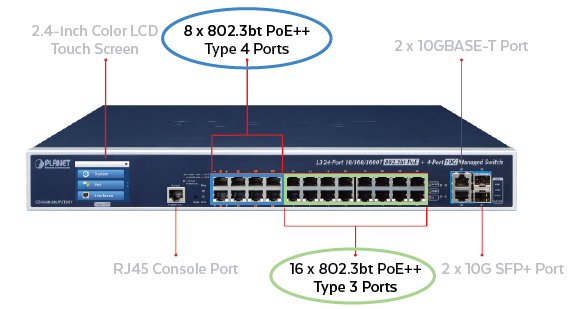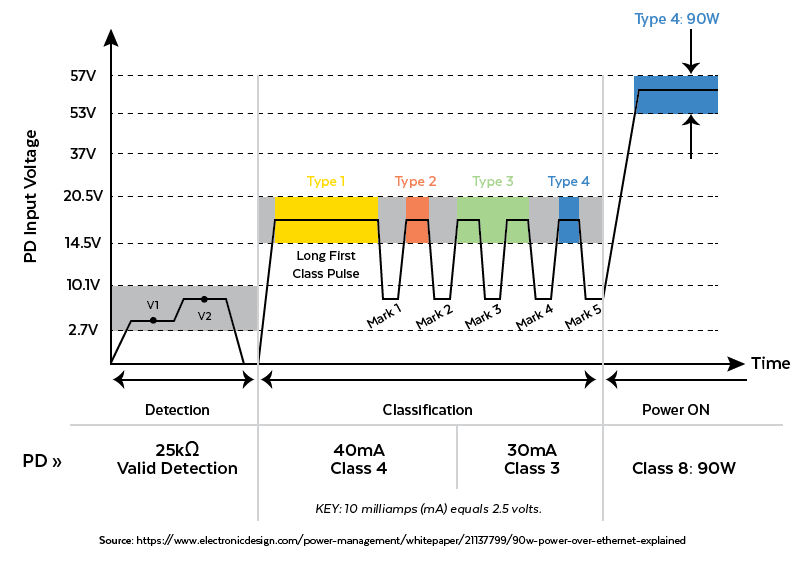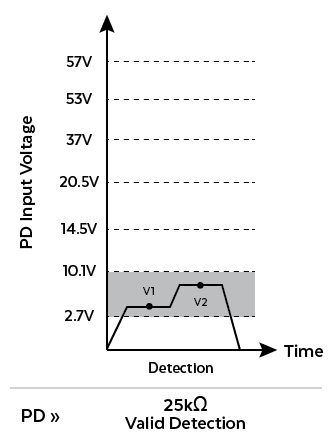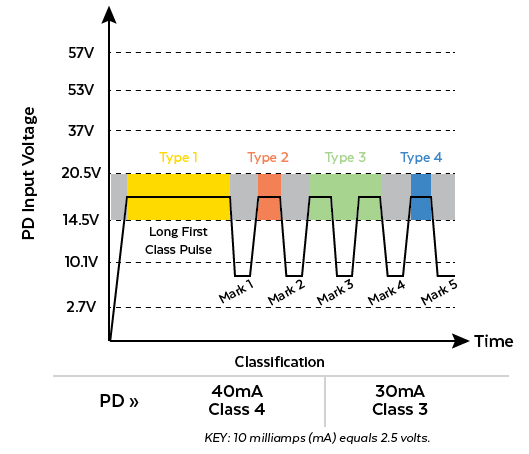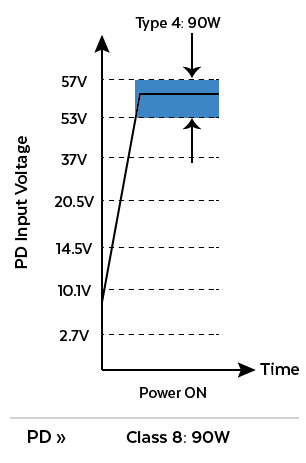The consumer sees the increasingly further development of the IEEE Power over Ethernet (PoE) standards every couple of years. This drive to develop more sophisticated levels of powered devices (PD) has led to the latest 90W capability. The IEEE 802.3bt powers thin client computers, televisions, video conferencing technologies and high-performance wireless access points.
The latest PoE iteration—also known as Type 4 PoE—transmits up to 90W of DC power and data over a single Cat5e, Cat6, or Cat6A Ethernet cable, while removing the need for nearby power sources or electrical outlet installs. Cost efficiency is a key driver in its popularity.
The GS-6320-24UP2T2XV Gigabit 802.3bt PoE Managed Switch offers Type 3 and Type 4 ports, along with intelligent PoE functions and more. Learn more here.
Power sourcing equipment (PSE), like the one pictured above, offers the end user a mixture of IEEE 802.3bt features such as Type 3, and the more recent and powerful Type 4. The reality is that every type of PoE powered device can be attached to that switch, regardless of the IEEE 802.3 standard. Having Type 3 and Type 4 ports means it can support devices that require higher levels of power.
Understanding how your PSE makes that connection can give you peace of mind as you opt for more flexible PSE purchases. A switch offering Type 4 can accommodate 90W PDs and the other devices you may have.
The Difference Between 2-Pair and 4-Pair PoE Transmission
To begin, each of the four types of PoE transmits data and power through the Ethernet cable over two or four twisted pairs. The process uses phantom power to transmit both (data and power) without interference between the transmission.
In a two-pair power configuration (802.3af, 802.3at), one twisted pair is positive and the other is negative. In a four-pair power configuration (802.3bt), two twisted pairs are positive and two are negative.
Whatever the PoE standard, a device requires is enabled by the PSE, which can power the twisted pairs in either polarity. The input bridges (diodes or FETs) of the PD automatically set the polarity of the incoming power.
The Progression Of PoE Power Level Improvements
To date, there are four IEEE 802.3 standards: Type 1 (802.3af), Type 2 (802.3at/PoE+), Type 3 (802.3bt/UPoE), and Type 4 (802.3bt).
Type 3 and Type 4 Drill Down
A piece of power sourcing equipment (PSE)—such as a switch, hub, extender—transmits power over either 2 or 4 of the twisted pairs of copper wiring inside the Cat5e Ethernet cable or higher. A key differentiator in PoE Type is how many of the four pairs transmit power. Types 3 and 4 both use 4-pair.
How Actual PoE Device Communications Works
The PSE communicates with the PD through a series of low-voltage pulses in a two-step process. This progression, known as the two-step handshake, is a term that might be misleading because the number of pulses is often more than two.
The first step detects the PD.
The second classifies what kind of PD it is and how much power it needs.
Once that identification occurs, power is sent, and the device can turn on. The following is a detailed description of this process.
Detection
The detection process determines the appropriate power required by the PD coming online. In step one of the detection phase, the PSE determines if the connected device is requesting power.
STEP ONE: The PSE sends two voltages between 2.7 and 10.1 V onto the Ethernet cable, and the PD presents a 25 kΩ (103 ohms or kiloohms) resistance. This pulse signals to the PSE that the connected PD requires power.
STEP TWO: The PSE sends between 2.7 and 10.7 V onto the Ethernet cable to check for a valid detection signature of 25 kΩ.
Classification
Once PD detection occurs, the PSE and PD then do an analog handshake known as classification. The PD then requests a power classification to which the PSE replies to the PD what classification is granted. This process is known as the handshake.
TYPE: the kind of analog handshake from the PSE.
CLASS: refers to the maximum power the PSE sends over the cable and the maximum power the PD can draw from the cable.
The problem engineers needed to solve in the classification stage was how to differentiate between PoE standards without sending too much voltage that could damage equipment. Too high of a power surge could damage a legacy device or one that requires less power.
The answer was simple. Instead of one big pulse, the PSE could send one additional low-voltage pulse for each Type of PoE (see illustration below).
Type 4 Classification
Type 4 uses five pulses. It draws 40 mA (milliamps = 0.001 AMP) for the first two pulses and then lowers its current draw to the classification signature 3, 2, 1, or 0 for the subsequent pulses. Once the PSE classifies the PD, the PSE doesn’t always grant the PD the power.
PSE Power Budgets And Power Demotion
PoE-enabled Ethernet switches have a limited power budget. Knowing this budget allows you to plan which devices you can plug into a switch. The switch at the top of the blog has a total PoE budget of 600W. Not surprisingly, 90 W per port adds up quickly.
When a device asks for more power than is available, the PSE will still power the PD but with less power than the PD requested. The amount of power that the PSE sends demotes down to a lower Type.
The PSE will send the highest class of power available in whatever Type has enough to transmit from the remaining supply the switch budget allows.
For example, say the switch at the top of the blog only has 68W remaining of its 600W power budget, and the PD is asking for 90W. The PSE will demote the delivery amount from 71.3, the appropriate Class 8 amount down to 51W, which is the top of Type 3, Class 6.
If you would like help choosing a PSE to support a 90W PoE device, feel free to contact us.

